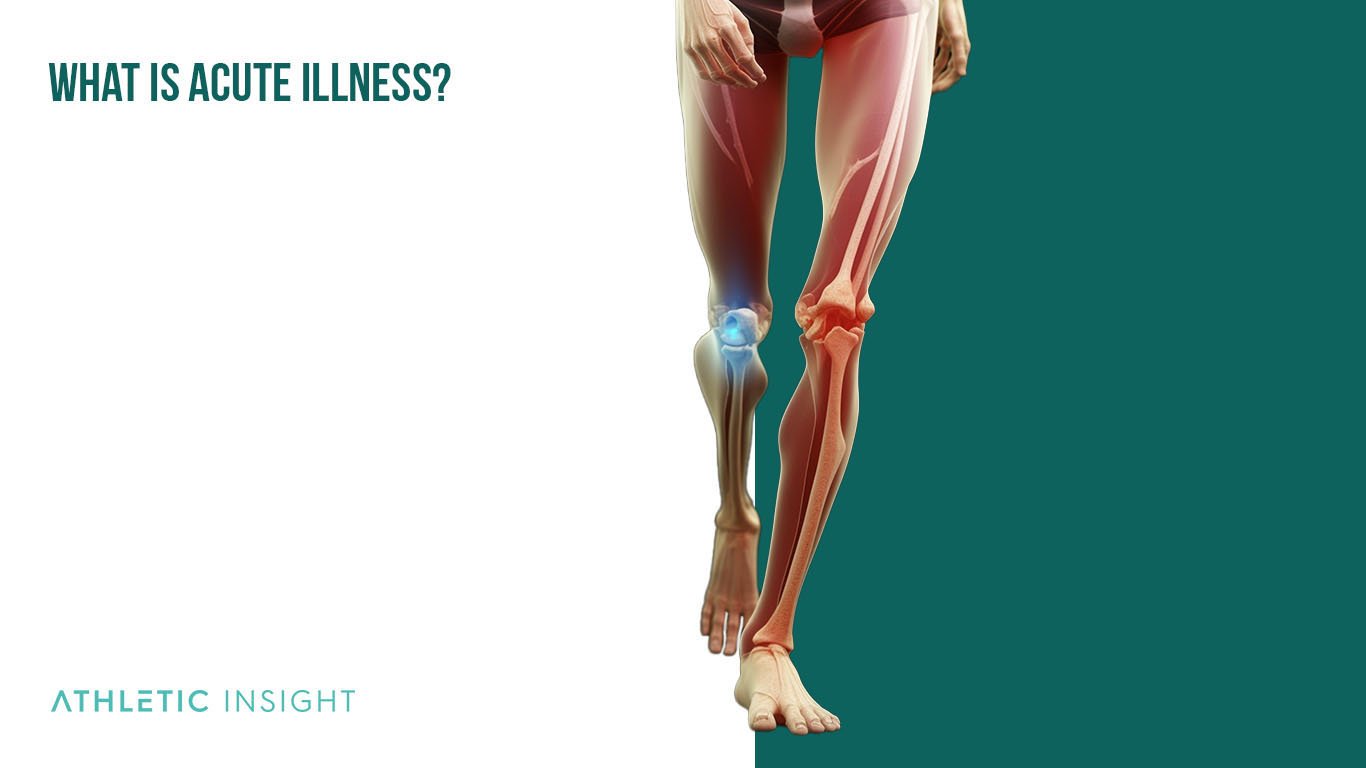Acute illnesses are medical conditions that manifest rapidly and typically resolve within a short period. This article aims to provide an in-depth understanding of acute illness, including its definition, types, causes, diagnosis, symptoms, signs, and treatment options. We also explore the difference between acute and chronic illnesses and the potential complications of acute conditions.
What Is Acute Illness?
An acute illness is a medical condition characterized by sudden onset, rapid progression, and a relatively short duration. These illnesses often require immediate medical attention and may range from mild to severe. While some acute illnesses resolve on their own, others may necessitate targeted treatment to prevent complications and promote recovery.

What Are the Types of Acute Illness?
Acute illnesses can be classified into five types, including infections, cardiovascular events, respiratory disorders, gastrointestinal conditions, and neurological emergencies.

- Infections: Influenza, pneumonia, urinary tract infections
- Cardiovascular events: Myocardial infarction (heart attack), stroke
- Respiratory disorders: Asthma exacerbation, acute bronchitis
- Gastrointestinal conditions: Gastroenteritis, appendicitis
- Neurological emergencies: Meningitis, seizures
What Causes an Acute Illness?
Acute illnesses can be caused by four main factors, such as infections, inflammation, environmental factors, and genetic predisposition.

- Infections: Bacterial, viral, fungal, or parasitic infections can lead to acute illness.
- Inflammation: An immune system response to injury or infection may cause inflammation and contribute to the development of acute illnesses.
- Environmental factors: Exposure to toxins, allergens, or irritants can precipitate acute illness.
- Genetic predisposition: Genetic factors may increase susceptibility to certain acute illnesses.
How Are Acute Illnesses Diagnosed in Clinical Practice?
Acute illnesses are diagnosed in clinical practice using four main methods, these include medical history, physical examination, laboratory tests, and imaging studies.
- Medical history: Obtaining a detailed patient history, including symptoms, onset, duration, and potential triggers.
- Physical examination: Assessing vital signs, inspecting the affected area, and performing relevant tests.
- Laboratory tests: Analyzing blood, urine, or other samples to identify pathogens or abnormal values.
- Imaging studies: Using X-rays, computed tomography (CT) scans, magnetic resonance imaging (MRI), or ultrasounds to visualize internal structures.
What Are the Common Symptoms and Signs of Acute Illness in Different Body Systems?
Common symptoms and signs of acute illness in different body systems include seven different symptoms. These common symptoms include respiratory, cardiovascular, gastrointestinal, neurological, urinary, musculoskeletal, and integumentary.
- Respiratory: Cough, shortness of breath, chest pain, wheezing
- Cardiovascular: Chest pain, palpitations, shortness of breath, dizziness, fainting
- Gastrointestinal: Abdominal pain, nausea, vomiting, diarrhea, constipation
- Neurological: Headache, confusion, altered mental status, seizures, muscle weakness
- Urinary: Painful urination, increased frequency, urgency, changes in urine color or odor
- Musculoskeletal: Joint pain, swelling, muscle pain, limited range of motion
- Integumentary: Rashes, swelling, bruising, discoloration
What Is the Pathophysiology of Acute Illnesses?
The pathophysiology of acute illnesses varies depending on the specific condition but often involves a rapid response to an underlying trigger, such as infection, inflammation, or injury. This response can lead to a cascade of physiological changes, including immune activation, tissue damage, and organ dysfunction, which manifest as the signs and symptoms of the acute illness.
What Are Examples of Acute Illnesses?
Examples of acute illnesses include influenza, pneumonia, appendicitis, myocardial infarction (heart attack), stroke, meningitis, acute bronchitis, and gastroenteritis.
- Influenza
- Pneumonia
- Appendicitis
- Myocardial infarction (heart attack)
- Stroke
- Meningitis
- Acute bronchitis
- Gastroenteritis
How Are Acute Kidney Injuries (AKIs) Classified and Treated?
Acute kidney injuries are classified into three stages based on the severity of kidney dysfunction, as determined by the increase in serum creatinine levels and the decrease in urine output. Treatment for AKIs typically involves identifying and addressing the underlying cause, providing supportive care to maintain fluid and electrolyte balance, and, in severe cases, initiating renal replacement therapy such as dialysis.
How Are Acute Neurological Emergencies Treated in The Emergency Department?
Acute neurological emergencies are treated in the emergency department by promptly assessing the patient’s neurological status, stabilizing vital signs, administering appropriate medications, and providing supportive care. In some cases, surgical intervention or consultation with a neurologist may be necessary.
What Are the Differential Diagnoses for Acute Respiratory Distress Syndrome (ARDS)?
Differential diagnoses for acute respiratory distress syndrome include heart failure, pneumonia, pulmonary embolism, pulmonary edema, and aspiration pneumonitis.
- Heart failure
- Pneumonia
- Pulmonary embolism
- Pulmonary edema
- Aspiration pneumonitis
How Is the Treatment for Acute Illness?
The treatment for acute illness recovery depends on the specific condition, its severity, and the patient’s overall health. Treatment options may include medications, supportive care, surgical interventions, and specialized care.
- Medications: Antibiotics, antivirals, analgesics, or anti-inflammatory drugs
- Supportive care: Fluid and electrolyte management, oxygen therapy, or nutritional support
- Surgical interventions: In cases where organ obstruction or damage requires prompt surgical intervention
- Specialized care: Consultation with medical specialists, such as cardiologists, neurologists, or gastroenterologists
What Are the Common Complications of Acute Myocardial Infarction (AMI)?
Common complications of acute myocardial infarction include arrhythmias, heart failure, heart failure, cardiogenic shock, pericarditis, and ventricular rupture.
- Arrhythmias: Abnormal heart rhythms
- Heart failure: Inability of the heart to pump blood effectively
- Cardiogenic shock: A severe drop in blood pressure due to the heart’s inability to supply enough blood to the body
- Pericarditis: Inflammation of the pericardium, the sac surrounding the heart
- Ventricular rupture: Tearing of the heart muscle, which can be life-threatening
What Is the Role of Inflammation in The Development of Acute Illnesses?
Inflammation plays a crucial role in the development of acute illnesses by initiating the body’s immune response to infection, injury, or other insults. While inflammation is a natural and necessary process for healing, excessive or prolonged inflammation can cause tissue damage, contribute to the severity of the acute illness, and potentially lead to chronic health issues.
How Are Acute Infections Diagnosed in Hospitalized Patients?
Acute infections in hospitalized patients are diagnosed through a combination of clinical assessment, laboratory testing, and imaging studies.
- Reviewing the patient’s medical history and symptoms
- Physical examination to identify signs of infection
- Collecting and analyzing blood, urine, or other samples for the presence of pathogens
- Performing imaging studies, such as X-rays or CT scans, to visualize the affected area and assess the extent of the infection
How Does Anti-Inflammatory Food Help Treat and Prevent Acute Illnesses?
Anti-inflammatory foods, such as fruits, vegetables, whole grains, and lean proteins, can help treat and prevent acute illnesses by reducing inflammation in the body. These foods contain essential nutrients and antioxidants that support the immune system, promote tissue repair, and help maintain overall health. A diet rich in anti-inflammatory foods may help decrease the severity and duration of acute illnesses and reduce the risk of complications.
What Is the Mechanism of Action of Common Medications Used In the Management Of Acute Illnesses?
The mechanism of action of common medications used in the management of acute illnesses varies depending on the specific drug and the condition being treated. Examples include antibiotics, antivirals, analgesics, and anti-inflammatory drugs.
- Antibiotics: Inhibit bacterial growth or destroy bacteria
- Antivirals: Interfere with viral replication and disrupt the viral life cycle
- Analgesics: Relieve pain by reducing the perception of pain signals in the brain
- Anti-inflammatory drugs: Reduce inflammation by inhibiting the production of inflammatory chemicals in the body
Is Asthma a Type of Acute Illness?
No, asthma is a chronic illness characterized by recurrent episodes of airway inflammation and narrowing. However, an asthma exacerbation, during which symptoms worsen rapidly, can be considered an acute illness that requires immediate medical attention.
Can Acute Illness Cause Death?
Yes, acute illnesses can cause death, especially if they are severe, progress rapidly, or are left untreated. Timely diagnosis and appropriate treatment are crucial to prevent life-threatening complications and improve the prognosis.
Can Acute Illness Turn Into a Chronic Illness?
Yes, in some cases, an acute illness can progress to a chronic illness if it is not adequately treated or if underlying factors, such as genetic predisposition or environmental triggers, contribute to its persistence.
Can Sports Performance Cause Acute Illnesses?
Yes, sports performance can cause acute illnesses, particularly if the athlete pushes their body beyond its limits or suffers an injury. Examples of acute illnesses related to sports performance include heatstroke, exercise-induced asthma, overuse injuries, and acute dehydration.
- Heatstroke: A life-threatening condition caused by the body’s inability to cool itself during intense physical activity in hot environments
- Exercise-induced asthma: A sudden narrowing of the airways triggered by physical exertion
- Overuse injuries: Acute inflammation or damage to muscles, tendons, or ligaments due to repetitive stress
- Acute dehydration: A rapid loss of body fluids and electrolytes during strenuous exercise, leading to impaired physiological function
What Is the Difference Between Acute Illness and Chronic Illness?
The primary difference between acute and chronic illnesses lies in their duration and progression. Acute illnesses are characterized by a sudden onset, a rapid progression, and a relatively short duration, typically resolving within days to weeks. In contrast, chronic illnesses develop gradually, persist for an extended period, often lasting months to years, and generally require long-term management.



